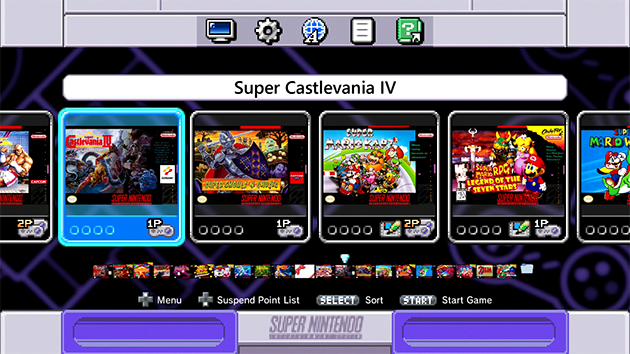
As a general rule, any new media device will, within 24 hours of its release date, be hacked. Sometimes people will just want to figure out how to make the original “Doom” run on anything with a screen attached; other times, it’s to expand your options with a media device.
Nintendo’s SNES Classic is no particular exception to the rule. It’s a small Linux-based device that you can plug into any TV or monitor with an HDMI port, and comes packed with 21 of Nintendo’s greatest hits from the ’90s. They were hard to find around the time they came out, but since then, the hype has died down and the secondary market is flooded with the things.

Within a couple of days of its original release, there were already homebrew programs that you could use to add games to the Classic’s built-in library. By now, most of the rough edges have been sanded off, and hacking a Classic is an easy, relatively painless process. If you’re like me, you probably think the Classic library has a few serious omissions. (“Final Fantasy III” but not “II”? No “Chrono Trigger”?)
This hack lets you expand the roster of games considerably. (Of course, this assumes that you didn’t “fix” the “problem” by doing something like using a Raspberry Pi to create a platform for every video game ever made. This is more of an intro-level article for people who might otherwise have been unaware that this sort of thing is even possible.)
In order to add a game to the SNES Classic, you’ll first need to get a copy of that game as a ROM image. These files, often simply called “ROMs” online, are made from read-only memory chips, such as those found within video game cartridges. If you still have your old SNES games lying around, as I do, you can use homebrew gadgets like a Retrode to dump your cartridges into ROM format. Nintendo in particular has always insisted that this is the only legal method of using ROMs and emulators, as a backup for media that you already own in a physical format. You can also grab all sorts of public-domain and homebrew games for the SNES at sites like PDROM. (Now you can finally play all those ultra-hard Super Mario World ROM hacks in the comfort of your living room, where presumably there’s more stuff available for you to break.)
Once you have some games to throw on there, the easy-mode way to do this is with Team Shinkansen’s hakchi2 program, available at GitHub. Assuming you have a PC running Windows, download hakchi2, unzip it, and run the .exe file. When prompted, select the appropriate region for your console, presumably the USA/Europe SNES.

Next, click on the Kernel menu and select “Dump kernel.”

At this point, hakchi2 will have some on-screen instructions for you to follow. Use the SNES Classic’s USB power cord to connect it to your PC, hold the Reset button, and turn on the Classic. Release the Reset button after a few seconds–the LED power light on the Classic should not be lit at this point–and if this is the first time you’re soft-modding your system, you’ll need to install a driver now. All of this backs up the SNES Classic’s original information as an .img file in hakchi2/dump/, which will come in handy in case something goes terribly wrong.
Now you can select “Add more games” from the File menu. Select all your ROMs and throw them on there. At this point, you can right-click on the games you plan to add to the Classic and opt to either add your own custom box art or have the program automatically Google for whatever it can find. (This can be a bit dangerous.)

Once your games are on there, push the Synchronize select games with NES/SNES Mini button, and when asked if you want to flash the custom kernel to your Classic, press Yes. Once it’s done, press OK to continue.
The next time you boot up your SNES Classic, there should be a new folder called Other games on your menu.

Select it to find and play the ROMs you added.

And why have I added the notoriously awful Spider-Man & the X-Men: Arcade’s Revenge to my SNES Classic? Because you need to know that this technology, like any technology, can be horribly misused. Don’t let games like this happen to you.
The SNES Classic ships out of the box with approximately 250MB of storage space, and an SNES game can be anywhere from 0.2 to 6 MB. It’s big enough for a personalized “greatest hits” roster, but not enough for a portable SNES archive. You can, however, further modify a Classic to run off of external storage, which remedies that problem.
Further, the Classic is essentially an emulator, and as with any emulator, there are some games that don’t play well or at all on it. The regulars over at /r/miniSNESmods have compiled a Google document that lists what games do and do not run on an SNES Classic, but some tinkering and occasional hex editing has managed to fix many of the holdouts. Just don’t be surprised if your favorite obscure titles don’t run as well on your Classic as you might hope.
In general, this was utterly painless and I was surprised by how easy it was. The SNES Classic is a nice, lightweight, easy-to-use machine, and my only real complaint with it is that the shield on the front of the unit feels really flimsy. It’s a great addition to your library of titles, and is probably the cheapest way in 2018 to get hold of Super Metroid.
Of course, now that I’ve finally gotten around to hacking the thing, we all get to go through the whole thing over again later this year when Sega releases the MegaDrive Mini.



